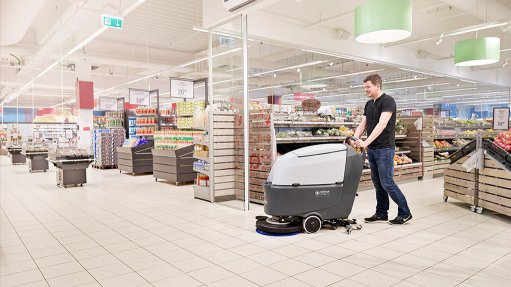
With competition for a share of consumers’ wallets becoming ever fiercer, retailers and retail property owners are going all out to attract shoppers. This has become crucial to their survival in an environment where consumer confidence and spending are hampered by a lacklustre economy.
“Retail property owners have taken bold steps to grow the foot traffic they need to remain viable,” says Emma Corder, country manager for Nilfisk South Africa. “Large capital expenditure projects like regional mega malls and refurbishments can win them only so much room to manouevre. Thereafter, shoppers have to be encouraged to keep returning by creating an experience that appeals to them.
“There is a mounting body of evidence that people care very deeply about the environment that retailers create for them. It should come as no surprise that substantially more than 90% of shoppers say they expect these spaces to be clean and well-kept. This represents clear, low-hanging fruit that the retail sector can grab to remain relevant.”
Nilfisk is a leading global provider of professional cleaning products and services across many industry sectors, including retail.
International studies show that as many as 99% of shoppers say poor cleanliness would negatively affect their perception of a retail environment. Not surprisingly, unclean washrooms and unpleasant odours rate higher than poor customer service in turning consumers away.
For instance, consumer responses show that the vast majority would ask to be moved to a new hotel room if the bedding is not clean, and that they doubt the safety of food being served if a restaurant’s restrooms are not clean. Similarly, they’re more likely to recommend a restaurant if it is clean, and many people are willing to overlook slow service if a business is noticeably clean.
While it may seem obvious, this key insight could prove to be the difference between a shopping centre or retail store outperforming nearby competition.
Corder notes that in many instances, investing in suitable cleaning equipment does not garner enough attention.
“Purchasing cleaning products is often seen as a grudge purchase and whilst many retailers aim to bolster their cleaning resources there are also those who invest very little or choose only to do so at certain times of the year, e.g. just before an audit is due.
“Overall, the investment in cleaning products is inconsistent and the staff is often left using products that are not part of the original cleaning specification. For a supplier, it’s important to offer a consistent standard especially when servicing a chain of the same stores,” says Corder.
Corder points out that throughout the years of supplying the retail industry, Nilfisk has gained in-depth insight into the challenges that both the supplier and customer face.
“The labour contingent in retail plays a significant role in maintaining a hygienic environment,” she says.
According to a report released in July by commercial real estate investment advisors JLL, trading density growth in South Africa has slowed across all types of shopping centres. Also, in the first quarter of this year the average vacancy rate rose to 4.2% from 4% in the previous quarter, and smaller retail centres continue to outperform larger ones.
Another study, done for the South African Council of Shopping Centres, shows there is an estimated 3.4 million square metres of gross lettable area (as of July 2017). On top of this, 17 shopping centres were expected to be completed last year, with a staggering 1.9 million square metres across 68 centres expected to be completed this year.
“One wouldn’t want to speculate that we’ve reached saturation level, but it is clear that competition to attract consumers to support these centres is going to be tough,” she says. “Given the high priority that consumers place on the cleanliness of these spaces, it represents an easy and quick win for property and mall managers who need to see return visits by shoppers.
“And today’s battle to increase trading density is one that doesn’t even begin to touch on the challenge being posed by online shopping. The e-commerce numbers in South Africa are still dwarfed by physical retail store sales, but that is sure to change in the near future.”
Corder argues that this is another compelling reason for retailers to protect their turf by making the retail environment all the more attractive. And by comparison, keeping spaces clean and appealing is far more cost effective than building out new features and attractions.